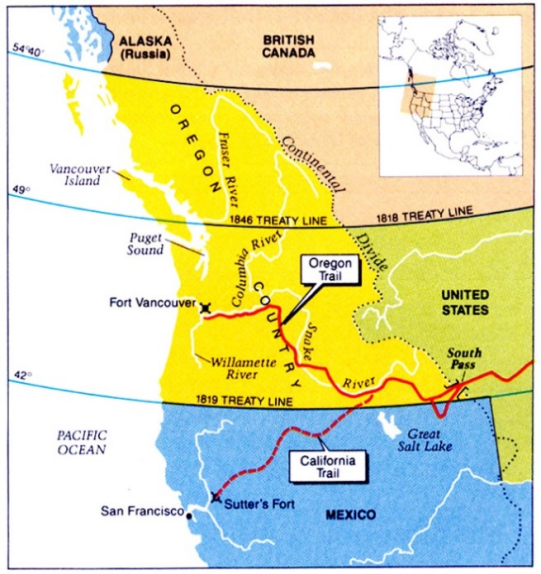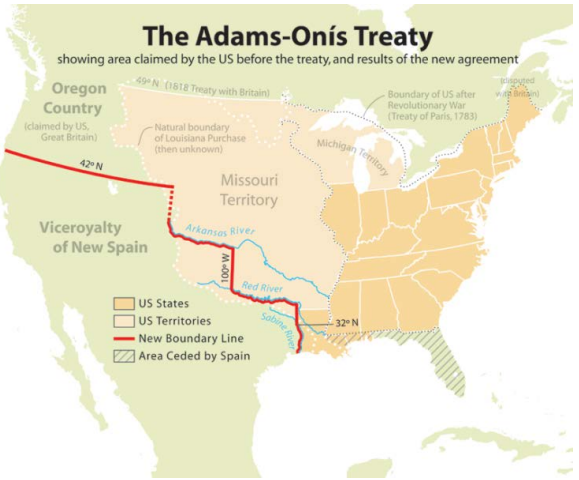Section #10 - A Manifest Destiny craze results in the Texas Annexation and a victorious war with Mexico
Chapter 119: The Oregon Boundary Dispute With Britain Is Resolved
1800-1840
The Oregon Boundary Lines Remain In Dispute

As the war with Mexico gets underway, Polk acts to resolve another long-standing territorial dispute, this time with Great Britain.
In question is a vast area in the Pacific Northwest, known to the Americans as the Oregon Country and to the British as the Columbia District of the Hudson Bay Trading Company.
Over time this land has played an important role in development of the fur trading industry.
America first enters the region in 1805, when Jefferson’s Lewis & Clark expedition reaches the headwater of the Columbia River, where it subsequent empties into the Pacific. In 1811 a mission, funded by the tycoon, John Jacob Astor, arrives there and builds Ft. Astoria, a fur trading station servicing both Astor’s Pacific Fur Company and another British competitor known as The North West Company.
The British seize Ft. Astoria during the War of 1812 and rename it Ft. George, until the 1814 Treaty of Ghent returns conditions to the status quo ante.
President James Monroe attempts to settle the Oregon borders with Britain during his first term.
In 1818 he tries to gain acceptance of the 49th parallel as the northern demarcation between Canada and the U.S., but Britain demands a line further south, for direct access to the Columbia River port. These talks end with a ten year “joint occupation” agreement allowing settlers from both countries to live side by side.
Monroe’s negotiations with Spain over the southern border are more successful and the 1819 Adams-Onis Treaty sets the 42nd parallel as the boundary between the Oregon and Spanish California. (This is also the same treaty that sets the Texas line along the Nueces River, which Polk bemoans in his inaugural address.)

Over the next two decades, Oregon develops gradually, with Ft. Vancouver, 90 miles inland from Ft. Astoria, becoming the hub of the fur trade, and the Hudson Bay Company reasserting its dominance. The 1818 “joint occupation” bargain with Britain is extended in 1827.
But things begin to change in the early 1830’s, as the Oregon Trail becomes passable for pioneer families, not just for independent mountain men. American settlers flock into the region, build homesteads, and vastly outnumber the British. As with the Texans, the Oregon population now looks to Washington to validate their land claims.
June 18, 1846
Polk Secures A Final Treaty On Oregon With Whig Support
The demands of the Oregon settlers are reflected in the Democratic Convention platform of 1844, and Polk himself reinforces them in his March 4, 1845, inaugural address:
Our title to the country of Oregon is ‘clear and unquestionable’ and already are our people preparing to perfect that title by occupying it with their wives and children.
Once that assertion is made public, a final resolution with Britain on the exact northern boundary becomes a necessity.
Some Western hawks in Congress rally behind the slogan “fifty-four forty or fight,” a line that would gouge 300 miles north into British Canada. But Polk and his Southerners hope to solve the issue without the war that would likely follow.
Early discussions with England go badly. Polk’s “blustering announcement” in his inaugural being booed roundly in the British parliament.
Things worsen with a clumsy July 16 letter from Secretary of State James Buchanan to Sir Richard Packenham, which first reiterates America’s right to the entirety of Oregon, then backs off to a 49th parallel compromise in the “spirit of moderation.” Packenham rejects the terms outright, refuses even to forward the letter to Prime Minister Peel, and declines to offer a counter-proposal. In turn, Polk takes his initial proposal off the table.
Within the cabinet, Polk and Buchanan go head to head, with the Secretary calling for accommodation and the President intent on staying silent and forcing Britain’s hand. As Young Hickory says, “the only way to treat John Bull is to look him straight in the eye.”
In December 1845 the Oregon border issue heats up in Congress, as westerners again demand the fifty-four forty solution, southerners support the 49th parallel, and northerners simply wishing to avoid war with Britain. The debate in the House carries over to the New Year, where a first term congressman from Ohio named John Cummins articulates a vision for an America in possession of the Oregon country:
(Oregon) is the master key of the economic universe, with flourishing towns and embryo cities (facing toward the Asian markets.) The commerce of the world would thus be revolutionized…Britain must lose her commercial supremacy in the Pacific…and (trading partners) must pay tribute to us.
On February 9, 1846, the House passes a bill calling on Polk to terminate the “joint occupancy” agreement with Britain inside of one year – while also encouraging a new border settlement that is amicable. When the bill goes to the Senate, the western wing of the Democratic Party led by Lewis Cass and the southern wing led by Calhoun clash, to Polk’s dismay. This persists until April 23, when a re-written joint “termination” directive passes the House 142-46 and the Senate 42-10.
Now the ball is back with the British, and a revised Parliament looking for resolution. On June 3, a letter from Packenham proposes a 49th parallel solution, as long as British settlers south of the line retain their lands, and access to the Columbia River is granted British ships. This breaks the stalemate, and on June 18, Polk sends a final treaty proposal to the Senate, which ratifies it by a 41-14 vote.
Remarkably, all 23 Whig senators support Polk’s measure – unlike his own Democrats who remain split.
Cass of Michigan is opposed to the compromise border. He is joined by other westerners including Atchison of Missouri, both senators from Illinois (Breese and Semple) and from Indiana (Hannegan and Bright), along with William Allen of Ohio, chairman of the Foreign Relations Committee, who resigns this post in protest.
Composition Of Senate Votes On The Oregon Bill
| Support | Oppose | |
| Democrats | 18 | 14 |
| Whigs | 23 | 0 |
But by early June 1846, the crafty Polk can declare victory on his promise to resolve Oregon, a move that adds a full 10% to America’s total land mass.
He now turns his attention back to progress on the tariff.